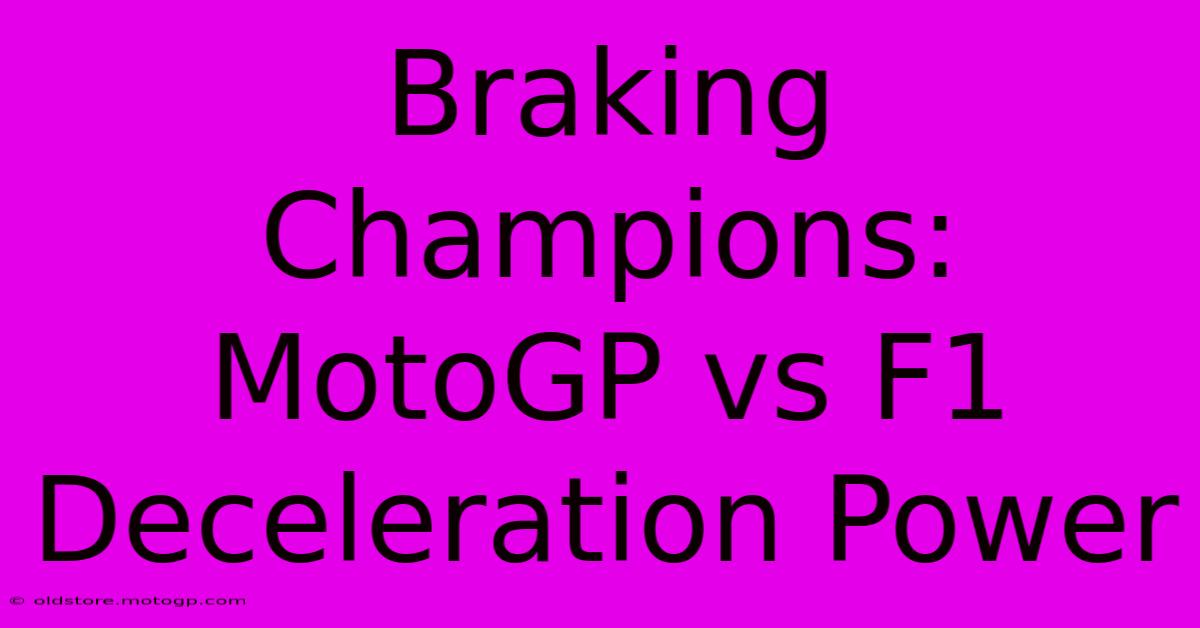Braking Champions: MotoGP Vs F1 Deceleration Power

Table of Contents
Braking Champions: MotoGP vs F1 Deceleration Power
The roar of the engines, the blur of speed, the breathtaking maneuvers… Formula 1 and MotoGP are pinnacles of motorsport, each demanding incredible skill and precision. But while acceleration often steals the spotlight, the power of deceleration is equally crucial, particularly in braking. This article delves into the fascinating world of braking in these two motorsports giants, comparing their deceleration capabilities and exploring the factors that contribute to their stopping power.
Deceleration: A Force to be Reckoned With
Both F1 and MotoGP bikes employ advanced braking systems, but their approaches differ significantly. Understanding the differences requires examining several key factors:
1. The Machines Themselves: Weight and Downforce
Formula 1 cars are significantly heavier than MotoGP bikes, typically weighing over 700 kg compared to a MotoGP bike's roughly 150 kg. This mass inertia means F1 cars require considerably more force to decelerate. However, F1 cars benefit from substantial downforce, generated by aerodynamic elements, which presses them firmly onto the track, increasing grip and braking efficiency.
MotoGP bikes, being much lighter, have lower inertia, making them easier to slow down. However, they rely less on downforce compared to F1 cars, meaning tire grip plays a more crucial role in braking performance.
2. Braking Systems: Technology and Techniques
Both disciplines use carbon fiber brake discs, known for their exceptional heat resistance, crucial for sustained high-performance braking. However, the brake system design and application differ considerably:
-
F1: Employs powerful hydraulic braking systems with multiple calipers gripping the discs on each wheel. Drivers use a sophisticated brake-by-wire system, allowing precise control and modulation.
-
MotoGP: Uses a more direct system where the rider's physical leverage determines braking force. Front braking dominates, often exceeding 90% of the total braking force, placing immense demands on the front tire. The rear brake is primarily used for stability and fine-tuning the bike's attitude during braking.
3. Tire Technology and Track Conditions
Tire technology plays a pivotal role in both sports. F1 tires are wider and more robust, offering greater contact patch and heat dissipation capacity. This contributes to their superior braking performance, especially under heavy braking loads.
MotoGP tires are slicks with specific compounds tailored for different track conditions. Their grip levels are exceptionally high, allowing for extreme deceleration. However, maintaining tire temperature and preventing overheating during intense braking is critical.
4. The Human Factor: Rider/Driver Skill
The human element is arguably the most significant variable. F1 drivers possess exceptional car control and are assisted by advanced driver aids. Their braking technique involves precise inputs through the brake pedal and steering, optimizing deceleration while minimizing instability.
MotoGP riders require an almost supernatural level of skill and finesse. They control the bike’s deceleration using their precise movements on the handlebars and their body position, actively managing the bike's weight and balance under extreme braking forces.
The Deceleration Showdown: Who Wins?
Quantifying the exact deceleration figures between F1 and MotoGP is difficult due to numerous variables. However, it's safe to say that F1 cars generally experience higher deceleration rates in terms of g-force, primarily due to the greater downforce and tire contact patches. MotoGP bikes, though lighter, rely more on the skill of the rider to achieve incredible stopping power, often in tighter corners and with less margin for error.
The true “winner” depends on how you define deceleration "power." F1 showcases higher G-forces, indicating raw stopping power, while MotoGP highlights the breathtaking human skill and finesse needed to achieve exceptional braking performance under extreme circumstances. Both are feats of engineering and human prowess.
Conclusion: A Symphony of Speed and Control
The comparison between F1 and MotoGP braking illustrates the fascinating interplay between engineering, technology, and human skill. While the numbers may differ, both disciplines demonstrate the vital role of deceleration in achieving ultimate performance. It's not just about speed; it’s about the controlled, precise deceleration that allows these champions to conquer the track.

Thank you for visiting our website wich cover about Braking Champions: MotoGP Vs F1 Deceleration Power. We hope the information provided has been useful to you. Feel free to contact us if you have any questions or need further assistance. See you next time and dont miss to bookmark.
Featured Posts
-
Moto Gp Qualifying Setting The Stage For Glory
Feb 21, 2025
-
Ride Cota Challenge Yourself On The Track
Feb 21, 2025
-
F1 Concert The Ultimate Motorsport Music Extravaganza
Feb 21, 2025
-
The Greatest Moto Gp Rider The Ultimate Accolade
Feb 21, 2025
-
Moto Gp Racing Time Travel Tips For Race Week
Feb 21, 2025
